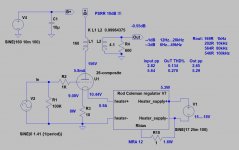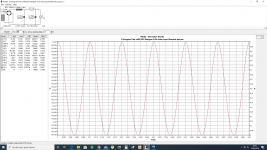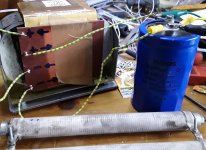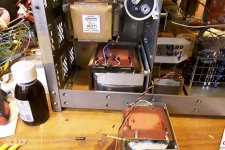I have 22k 2w resistors ...
But you need (22k*7mA) more B+.
But you need (22k*7mA) more B+.
Hi,
Yes, thanks for your reply!
I was going to try the 192v suggested on the Phaeton RC schematic. This is very close to what I have pre SSHV2. So if I skip the shunt reg for now I’ll be alright, I think. The raw supply is pretty well filtered as is.
The raw supply is pretty well filtered as is.
... but usually PSRR is very limited ...
The #26 is very sensitive to power supply, if you don't use active load (gyrator or CCS).
Temporary try to use with shunt regulator, even combined with voltage regulator tube.
Great to hear from you, Ale. I've stuck with the 26 because I like the sound in SIC bias - very grateful to you for turning me on to that. I run it at 7mA - it would be nice to have a bit more current but it seems to cope as a driver for the PSE 4P1Ls. I really have no desire to explore anything else, though as an experiment I'm building a 300b amp with 2 stages, where I'll use a driver with higher mu, probably one of the Russian pentodes you've been trying out in triode mode.
I've been doing quite a lot of songwriting recently since I have time on my hands, and this has taken me back to stage gear. I built a tube microphone and I'm currently building/modifying my bass guitars. So back to tone woods after almost exclusively doing metalwork. Next step is a tube amp for the bass like our friend Paul Leclercq is so into building. I know you play as well, and maybe stage gear will lure you next. You would have so much to offer the tube microphone and tube amp scene and you could really shake up the rather formulaic circuits being used. Like why are we using SIC bias/filement bias and gyrators/plate chokes for hi-fi amps and not for stage amps and microphones?
Hey Andy
Good to hear you’re ok.
I’m playing music at low level in the evenings as my daughters are sleeping in the room below, so this took me to use only one stage lately. I’m back on the 01a whilst I take the “Mule” back to the workshop for more experiments.
Time is very scarce for me am afraid as we are struggling with the kids at home locked down. A friend made me to order a nice cabinet I’m planning to use to slot in the IKEA chopping boards to speed up the build work. The cabinet has a door so can keep hands away from my kids.
Ive been exchanging quite a lot with Paul lately as we have experimented on different guitar amp driving stages with the 6Z49P and the 6F12P with great results. I finished my Marshall clone during Christmas and am happy with the sound of it. Unfortunately very little time for playing as well.
I experimented with germanium PNP fuzz stages, good fun.
So many projects and so little time. It’s a paradox as am locked down but the family is demanding all of my time left out of work. Fortunately for now, can work remotely. Not sure how long it can be handled this way.
Cheers
Ale
... but usually PSRR is very limited ...
The #26 is very sensitive to power supply,
So, after a few days of messing around with the circuit, I have it roughly up and walking.
Thanks Euro21, for your assistance. You were, of course, correct. Without the SSHV2 I got some woofer dancing, no matter what I tried. Any fluctuation in the mains (the refrigerator turning on, for e.g.) would set it off. So shunt supply it is.
RC plate loading does seam to work (22k, 220nF), at least with my amps and 1 meter interconnects. The operating conditions are still pretty sub-optimal. Even converting my raw HT PS to C-input, I don't have quite enough B+ for the 22K plate load @7mA.
BUT! I want to thank everyone who has contributed to this thread over the years. I appreciate that most everyone has tried to avoid hyperbole when discussing the 26 as a line amp, however, I now feel a little bit like I have been wasting my time building other things. Even under sub-optimal conditions, it is truly an entertaining little beasty.
One more question for anyone who cares to read:
For those who have tried both, Is it worth waiting (possibly) a couple of months for the LL2745? I believe the LL1660 10mA is in stock, and could probably get these much sooner.
With the RC plate load I have way too much gain for my system. At 8'clock I'm at nearly concert volume levels. So, I think transformer output/plate-load is the way to go for me at this point. (which is also what I originally had planned)
I hope that is not an annoying question!
Thanks in advance for your advice.
Regards,
John
For those who have tried both, Is it worth waiting (possibly) a couple of months for the LL2745? I believe the LL1660 10mA is in stock, and could probably get these much sooner.
With the RC plate load I have way too much gain for my system. At 8'clock I'm at nearly concert volume levels. So, I think transformer output/plate-load is the way to go for me at this point. (which is also what I originally had planned)
I hope that is not an annoying question!
Thanks in advance for your advice.
Regards,
John
I've been getting good results with parafeed in the headphone amps I'm currently experimenting with. Plate choke for the tube and a good coupling cap - I use Russian teflons, in parallel usually. For the 26 as a driver stage that's all I need. But if you want to step down the voltage I'm getting good sound out of mains toroidal transformers. I'm using a 230/12+12 toroid to give me 9.6:1 step-down. If you're in the USA 110/12 gives you 9:1 for instance. There's no DC in the signal so toroids work fine.
The stepdown OPT is good for output impedance and decrease gain, but this schematic also sensitive to power supply hum, the PSRR very low even if primary inductance is high.
This sample is quick modification of my older design of 10Y/801 preamp.
The preamp (I designed it a long time ago to my friend) was OPT loaded.
The line output transformer was a good (and horribly priced) Noguchi FM-24k-600 (24k:600, 160H primary inductance).
160H at 20Hz about 20kOhm. It was just enough (a little in the lower side) for 5k plate impedance tube.
#26 at about 150V has approximately 7k5 plate impedance, so even 160H inductance not optimal.
See the distortion numbers: with active load the THD is 0.00x% even at higher output.
The PSRR is unmanageably low, without regulated power supply this schematic is almost useless.
This sample is quick modification of my older design of 10Y/801 preamp.
The preamp (I designed it a long time ago to my friend) was OPT loaded.
The line output transformer was a good (and horribly priced) Noguchi FM-24k-600 (24k:600, 160H primary inductance).
160H at 20Hz about 20kOhm. It was just enough (a little in the lower side) for 5k plate impedance tube.
#26 at about 150V has approximately 7k5 plate impedance, so even 160H inductance not optimal.
See the distortion numbers: with active load the THD is 0.00x% even at higher output.
The PSRR is unmanageably low, without regulated power supply this schematic is almost useless.
Attachments
Thanks for your replies!
Sorry for the delayed response. I have been chasing down a hum in the preamp. Most of it was bad tubes, but it is still very sensitive to EMF, etc. The hum is nearly gone if I wrap the preamp in EMF cloth and ground it.
Eruo21: The schematic you linked is very similar to the one I have been following (Ale's 26 gen. 3). Thanks for this.
Andy: Parafeed could be interesting. I have read some of your posts on your implementation. The 126c is nearly as expensive as the Lundahl LL2745, and I would still have the gain issue. I could change the Voltage Amp in my power amps to a lower Mu tube, but I like the way it currently sounds. Not wanting to fix something not broke.
Thus my interest in the step-down OPT as plate load.
Sorry for the delayed response. I have been chasing down a hum in the preamp. Most of it was bad tubes, but it is still very sensitive to EMF, etc. The hum is nearly gone if I wrap the preamp in EMF cloth and ground it.
Eruo21: The schematic you linked is very similar to the one I have been following (Ale's 26 gen. 3). Thanks for this.
Andy: Parafeed could be interesting. I have read some of your posts on your implementation. The 126c is nearly as expensive as the Lundahl LL2745, and I would still have the gain issue. I could change the Voltage Amp in my power amps to a lower Mu tube, but I like the way it currently sounds. Not wanting to fix something not broke.
Thus my interest in the step-down OPT as plate load.
Mine attempt to implement choke input PSU for Rod Coleman heater regulators V6 following the kind advice of Ale Moglia (thanks friend).
Power transformer used Hammond 229D40 split bobbin transformers configured for 20V 2.4A because I have on hand and are cheap also Triad make similars (thanks Eduard).
About choke I choose Lundhal (for quality) Filament Current Choke LL1694 configured in series for 160mH resistance each winding 0.9Ω so total 1.8Ω
Mine Rod Coleman regulators V6 PSU needs 14.5Vout for 1.1A
Attached PSUDII simulation.
All suggestions to improve will be welcome.
TIA
Felipe
Power transformer used Hammond 229D40 split bobbin transformers configured for 20V 2.4A because I have on hand and are cheap also Triad make similars (thanks Eduard).
About choke I choose Lundhal (for quality) Filament Current Choke LL1694 configured in series for 160mH resistance each winding 0.9Ω so total 1.8Ω
Mine Rod Coleman regulators V6 PSU needs 14.5Vout for 1.1A
Attached PSUDII simulation.
All suggestions to improve will be welcome.
TIA
Felipe
Attachments
Last edited:
Hello Felipe,
Some ideas, advice lol
You can use the SBYV28-100 diodes ( very good test in Lineair audio magazine) AND mount them directly onto the pins of the transformer.
Use the LL1694 with one coil in the plus and one in the min like you can see in the LL1694 pdf.
Ask Lundahl to make the LL1694 not with 1,5 A cuurent rating but with a smaller airgap to make it 1,2A THEN you will get more mH ( around 190) . They can do at no extra cost.
The LL2733 will be better , if you ask it to make it for 1,2 A you will get more than 500 mH. BUT is higher dcr and you will not be able to use the 20 volt transformers. And it is a little bigger.
Use a bleeder resistor that will take care there is always some current running. With no current at all you will get 20*1,4 across the first cap. Just as extra safety you can add a 20 volt zener across the first cap so voltage will never go above 20 voits.
You must put the choke close to the rectifier/transformer combo and twist the wires..
You can also simulate the other things with psud.
You can also connect the choke in one correct way if you are using the connection i am using. There are two wires coming from the rectifier going in. The Lundahl has two '' coils ' Each one has a dot. One wire from the rectifier goes to the end of a coil with a dot. The other wire goes to the end of the other coil with no dot.
In my picture you can two arrows going inside the choke coming from the rectifier the two arrows going outside to the first capacitor.
Greetings, eduard
( pictures are from my DDDAC before i used LL2733 now i am using LL2771 ( 3000mH 1A )
Some ideas, advice lol
You can use the SBYV28-100 diodes ( very good test in Lineair audio magazine) AND mount them directly onto the pins of the transformer.
Use the LL1694 with one coil in the plus and one in the min like you can see in the LL1694 pdf.
Ask Lundahl to make the LL1694 not with 1,5 A cuurent rating but with a smaller airgap to make it 1,2A THEN you will get more mH ( around 190) . They can do at no extra cost.
The LL2733 will be better , if you ask it to make it for 1,2 A you will get more than 500 mH. BUT is higher dcr and you will not be able to use the 20 volt transformers. And it is a little bigger.
Use a bleeder resistor that will take care there is always some current running. With no current at all you will get 20*1,4 across the first cap. Just as extra safety you can add a 20 volt zener across the first cap so voltage will never go above 20 voits.
You must put the choke close to the rectifier/transformer combo and twist the wires..
You can also simulate the other things with psud.
You can also connect the choke in one correct way if you are using the connection i am using. There are two wires coming from the rectifier going in. The Lundahl has two '' coils ' Each one has a dot. One wire from the rectifier goes to the end of a coil with a dot. The other wire goes to the end of the other coil with no dot.
In my picture you can two arrows going inside the choke coming from the rectifier the two arrows going outside to the first capacitor.
Greetings, eduard
( pictures are from my DDDAC before i used LL2733 now i am using LL2771 ( 3000mH 1A )
Attachments
I can purchase standard LL1694 160mH 1.5A for 76€ each + 8€50 shipping expenses + 4% if I use Paypal, link: Lundahl LL1694, it's a good price?
Eduard if you use common mode connection, I guess you will get half inductance because you are using only one winding?
20 volt zener across 1st cap what power needed: 500mW or 1,3W?
Bleeder resistor value & power?
Eduard if you use common mode connection, I guess you will get half inductance because you are using only one winding?
20 volt zener across 1st cap what power needed: 500mW or 1,3W?
Bleeder resistor value & power?
Last edited:
Hello Felipe,
That is like a standard price i think prices in Europe will be the same.
I just checked my Lundahl LL2733 ( standard 400 mH 1,7A ) with smaller airgap is 544 mH 1,25A
There is a company in Estonia that also sells Lundahl so you can ask them to ask Lundahl to make your Lundahl with 1,25A current rating. Same price but better for you.
Lundahl Filament current choke, LL2733 - Fidelity Components Shop
You can pay with paypal but at no charge!
3 kilo with UPS is 28 euro think. But you can ask them.
If you connect them in common mode mH will be the same as like they are in series ( because they are in series!)
I would use 5 watt zener because if something is wrong like filament broken the voltage on the first cap will be around 28 volts.
If you have 16 volt dc on the first cap and use a 160 mH choke you will need minimum current of 100 mA (16/,160) If you have 544 mH you need just 30 mA
Power of the resistor 16 volt* 100 mA =1,6 watt so use 10 watt because it will get really hot. A professional 5 watt will be ok but better use 10 watt it will not be expensive.
Greetings, Eduard
That is like a standard price i think prices in Europe will be the same.
I just checked my Lundahl LL2733 ( standard 400 mH 1,7A ) with smaller airgap is 544 mH 1,25A
There is a company in Estonia that also sells Lundahl so you can ask them to ask Lundahl to make your Lundahl with 1,25A current rating. Same price but better for you.
Lundahl Filament current choke, LL2733 - Fidelity Components Shop
You can pay with paypal but at no charge!
3 kilo with UPS is 28 euro think. But you can ask them.
If you connect them in common mode mH will be the same as like they are in series ( because they are in series!)
I would use 5 watt zener because if something is wrong like filament broken the voltage on the first cap will be around 28 volts.
If you have 16 volt dc on the first cap and use a 160 mH choke you will need minimum current of 100 mA (16/,160) If you have 544 mH you need just 30 mA
Power of the resistor 16 volt* 100 mA =1,6 watt so use 10 watt because it will get really hot. A professional 5 watt will be ok but better use 10 watt it will not be expensive.
Greetings, Eduard
Thanks. What's the bleeder resistance value?
Cheers
Felipe
Hello,
16 volt divided by 160 ohm will give you 100 mA bleeder current.
With the 544 mH choke you can use 470 ohm that will give 34 mA and you will need a minimum of 29 mA so more than enough!
There will be people here that will tell you the circuit will give enough load. YES, but only if the tube is working.
Better be safe than sorry.
It is also better for the capacitors because the voltage will never rise to the maximum like it will do with no load at all.
Greetings, eduard
Hello Felipe,
I just wanted to share this information because using a choke input gives a lot of improvement for not to much money! Most of the Lundahl chokes ( they are my favorite ones) cost around 100 euro.
If you already have the transformer you will need another one because the choke will give a big voltage drop when used for choke input.
You need to take care about the critical inductance and you need to take care there is a resistor that '' bleeds '' the minimum current so it will always work as a choke input even if there are no tubes connected.
The best way to connect them i showed in the photos above but you can try the normal serie connection as well.
Take care that the wires between transformer, rectifier, input choke and first cap are SHORT.
You will need a bigger VA rating from the transformer because you must have a higher voltage. Suppose you have 300-0-300
I just wanted to share this information because using a choke input gives a lot of improvement for not to much money! Most of the Lundahl chokes ( they are my favorite ones) cost around 100 euro.
If you already have the transformer you will need another one because the choke will give a big voltage drop when used for choke input.
You need to take care about the critical inductance and you need to take care there is a resistor that '' bleeds '' the minimum current so it will always work as a choke input even if there are no tubes connected.
The best way to connect them i showed in the photos above but you can try the normal serie connection as well.
Take care that the wires between transformer, rectifier, input choke and first cap are SHORT.
You will need a bigger VA rating from the transformer because you must have a higher voltage. Suppose you have 300-0-300
- Home
- Amplifiers
- Tubes / Valves
- #26 pre amp




![LT_raw_supply[1].jpg](/community/data/attachments/770/770312-619205fe701c91537fc29506ece69960.jpg)